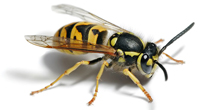Ants

There are actually 36 species of ant living in the UK, but there are two kinds – the Black Ant and Pharaoh's Ant – which attract the most attention and are generally the two species we encounter (certainly in our homes).
In their own outdoor environment (which includes your garden) ants actually have an important part to play and should generally be left undisturbed. Certainly they do no harm to your garden and in fact far more good.
If ants invade your home however, they can be a real pest so that’s what we’ll deal with here.
Why it is a pest
When ants invade your home it's for one reason only: food! They have a sweet tooth and are partial to syrups, jams, preserves and sugar.
Pharaoh's ants also like protein rich foods such as meat, cheese and fats. They will also forage for a source of water such as around sinks or where there is condensation.
Ants can be seen making a trail between their nest entrance and the food source as they transport food into the colony to nourish the workers and the queen inside.
Black ants do not transmit disease to humans but they do travel over dirty ground in their search for a food source and so could transfer bacteria, etc. to food and work surfaces.
Pharaoh's ants pose a greater risk to health as they are attracted to a wider range of food and sources such as drains and waste matter. Unless food is badly attacked by ants, the risk of infection is probably small, nevertheless most people find it unacceptable having ants indoors.
Biology of the Pest
Black Ants (also called Garden Ants) are about 4mm in length and are dark brown, almost black.
During the summer large numbers of both winged females and males are reared in the nest which is usually underground. On a few warm summer evenings they swarm from the nest entrances and take flight. During this brief flight they mate and on returning to the ground the males soon die.
The females then shed their wings and dig into the ground forming a small cell in which to lay the first of many eggs. They spend the winter in hibernation before starting in earnest the following spring. In favourable conditions the queen ant and her colony may survive for several years.
Pharaoh's Ants are only 1.5 - 2mm long and yellow-brown in colour
They are thought to have originated in Africa and did not spread northwards until buildings became better heated. They first appeared in Britain in the 19th Century but are now widespread throughout the UK.
Unlike Black ants, flying swarms of Pharaoh's ants are never seen as mating takes place inside the nest. An interesting feature they do share is that the ones doing the foraging, nest building and rearing – the worker ants – are females. They are also excellent communicators when food is found.
Signs of Pest Presence
Ants and trails in around the house, especially around doorways and entrances to your house, on worktops and food preparation areas and in food cupboards.
Removal Methods
Where ants become an indoor pest, the only real method of control is to locate the nest or colony by following the trail of ants. The nest can then be treated with an insecticidal dust or spray which is carried into the colony.
Whether you need help with a one-off pest removal, or are looking for regular service visits to minimise the possibility of a pest infestation causing impact on your business...
Call us on 07939964443
Prevention is better than Cure - Working with the Environment










